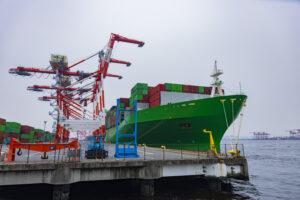Japan’s shipping and logistics landscape is a complex web of operations that is deeply intertwined with the country’s economy and global trade networks. As one of the world’s largest economies and a leading exporter, Japan plays a pivotal role in international trade. The sector is characterized by its adherence to high standards of efficiency and reliability. However, it faces numerous challenges and opportunities shaped by technological advancements, global events, and evolving consumer behaviors. This article aims to provide a detailed look into the current trends and future outlook of Japan’s shipping and logistics landscape.
Understanding Japan’s Shipping Industry: An Overview
Japan’s shipping industry is one of the most advanced in the world, featuring a robust network of maritime transport, air freight, and land logistics. The archipelago’s strategic geographic location facilitates trade with major economies in Asia, North America, and Europe. Japan’s maritime shipping is dominated by both domestic carriers and international players, ensuring a steady flow of goods across the Pacific and beyond.
The Japanese shipping industry is notably influenced by the country’s rich maritime history, which dates back centuries. This legacy has cemented Japan’s position as a leader in shipbuilding and maritime technology. The nation is home to some of the world’s largest shipping companies, which operate a fleet of advanced vessels equipped with cutting-edge navigation and cargo handling systems.
Recent years have seen Japan’s shipping industry grappling with challenges such as declining birth rates and an aging workforce. These demographic shifts have led to labor shortages, prompting companies to invest in automation and digital technologies to streamline operations. The COVID-19 pandemic further exposed vulnerabilities in the supply chain, leading to significant shifts in logistics strategies.
Additionally, Japan’s shipping industry is heavily regulated, with stringent safety and environmental standards that companies must adhere to. These regulations aim to protect the maritime environment while ensuring efficient operations. The government has also been proactive in promoting sustainable practices within the industry, recognizing the need to balance economic growth with ecological responsibility.
In response to global disruptions, the Japanese shipping industry has increasingly prioritized resilience and adaptability. Companies are focusing on diversifying supply chains and improving inventory management practices to mitigate risks associated with unforeseen events. This strategic shift not only enhances operational efficiency but also strengthens Japan’s position within the global market.
Overall, Japan’s shipping industry remains a vital component of its economy, characterized by its innovation, reliability, and commitment to sustainability. As the world evolves, so too does Japan’s approach to shipping and logistics, making it essential for stakeholders to stay informed about upcoming trends and shifts.
Key Players in Japan’s Logistics Sector: Who’s Who?
Japan’s logistics sector is comprised of a mix of established giants and emerging players, each playing a critical role in the supply chain. Major companies such as Nippon Express, Yamato Holdings, and Hitachi Transport System dominate the landscape, offering a comprehensive range of logistics services from warehousing to distribution. These companies have built extensive networks that facilitate both domestic and international trade.
Nippon Express, one of the largest logistics firms in Japan, has made significant investments in technology to enhance its service offerings. The company focuses on integrated logistics solutions, leveraging its global presence to optimize supply chain management for clients. With a commitment to innovation, Nippon Express is a leader in adopting digital platforms for real-time tracking and management of shipments.
Yamato Holdings, known for its ‘Takkyubin’ parcel delivery service, has transformed the logistics sector with its focus on last-mile delivery. The company has embraced technology to improve operational efficiency and customer service. Its success in the e-commerce segment has positioned Yamato as a key player in Japan’s growing online retail market.
Hitachi Transport System has also made strides in the logistics arena, particularly in the areas of IT and automation. The company’s use of data analytics to optimize routes and improve delivery times has set it apart from competitors. By integrating advanced technologies, Hitachi aims to provide smarter logistics solutions that cater to the evolving needs of its clients.
In addition to these industry giants, several startups are emerging in Japan’s logistics space, driven by innovation and a focus on sustainability. Companies like Lalamove and TabiLabo are leveraging mobile technology and data analytics to streamline logistics processes, enhancing speed and transparency. These newcomers contribute to a dynamic environment that fosters competition and encourages established players to adapt.
The collaboration between traditional logistics firms and tech startups is resulting in hybrid business models that enhance efficiency and customer satisfaction. As the landscape evolves, understanding the key players and their strategies becomes crucial for businesses looking to navigate Japan’s intricate logistics sector.
The Impact of Technology on Shipping in Japan
Technology is revolutionizing Japan’s shipping and logistics landscape, introducing efficiencies and capabilities that were once unimaginable. The adoption of automation and robotics is particularly significant in warehouses and distribution centers, where tasks such as sorting, packing, and inventory management are increasingly performed by machines. This shift not only accelerates operations but also addresses labor shortages in the industry.
In addition to automation, Japan is at the forefront of implementing Internet of Things (IoT) technologies to enhance supply chain visibility. Sensors embedded in containers and vehicles provide real-time data on the location and condition of goods, allowing companies to monitor shipments throughout their journey. This level of visibility significantly reduces the risk of delays and improves overall service quality.
Artificial Intelligence (AI) is being utilized to optimize logistics planning and decision-making. Companies are employing AI algorithms to analyze vast amounts of data, enabling them to forecast demand more accurately and refine their logistics strategies. This predictive capability allows firms to adjust their operations proactively, minimizing disruptions and enhancing customer satisfaction.
Blockchain technology is another area gaining traction in Japan’s shipping sector. By providing a secure and transparent method for recording transactions and tracking goods, blockchain enhances trust among stakeholders. This technology has the potential to streamline documentation processes, reduce fraud, and improve compliance with regulatory standards.
Moreover, Japan’s shipping industry is increasingly turning to eco-friendly technologies to reduce its carbon footprint. Electric and hybrid vehicles are being integrated into delivery fleets, while alternative fuels are being explored for shipping vessels. These initiatives align with global sustainability goals and position Japan as a leader in environmentally responsible logistics practices.
As technology continues to evolve, the shipping and logistics landscape in Japan will likely undergo further transformations. Companies that embrace innovation and adapt to new technologies will not only enhance their operational efficiency but also remain competitive in an increasingly complex global market.
Sustainability Trends in Japan’s Logistics Operations
Sustainability has become a crucial focus within Japan’s shipping and logistics sector in response to growing environmental concerns and regulatory pressures. The industry is actively seeking ways to reduce its carbon footprint, optimize resource utilization, and promote eco-friendly practices throughout the supply chain.
One significant trend is the rise of green logistics, which emphasizes sustainable transportation and warehousing options. Companies are investing in energy-efficient vehicles and eco-friendly packaging materials to minimize environmental impact. Additionally, logistics providers are exploring alternative modes of transport, such as rail and inland waterways, which can offer lower emissions compared to traditional trucking.
The Japanese government has also implemented policies to promote sustainable logistics practices. Initiatives such as the Green Logistics Partnership aim to enhance collaboration among stakeholders to develop environmentally friendly logistics solutions. This includes sharing best practices and incentivizing investments in sustainable technologies.
Moreover, companies are increasingly adopting circular economy principles, focusing on reducing waste and reusing materials. By redesigning supply chain processes to minimize waste generation, organizations can contribute to environmental preservation while also realizing cost savings. This shift is not only beneficial for the planet but also appeals to environmentally conscious consumers.
In response to these sustainability trends, many logistics firms are setting ambitious targets for carbon neutrality. For instance, some companies aim to achieve net-zero emissions by 2050, aligning with global climate goals. This commitment to sustainability is becoming a key differentiator in the competitive logistics landscape, as customers increasingly prioritize eco-friendly options.
As sustainability becomes a core component of logistics operations, companies must remain agile and proactive in their approach. By staying informed about emerging sustainability trends and innovations, businesses can position themselves as leaders in responsible logistics, ultimately enhancing their brand reputation and market presence.
How Global Events Shape Japan’s Shipping Landscape
Global events have a profound impact on Japan’s shipping and logistics landscape, influencing trade patterns, supply chain dynamics, and operational strategies. The COVID-19 pandemic, for example, has reshaped logistics operations worldwide, prompting companies to reevaluate their supply chains and adapt to new realities.
The pandemic exposed vulnerabilities in global supply chains, leading to delays and disruptions in shipping routes. In response, Japanese companies began diversifying their supply sources and reconsidering just-in-time inventory practices. This shift aims to build resilience against future disruptions while ensuring that businesses can meet consumer demand during crises.
Additionally, geopolitical tensions and trade disputes have influenced Japan’s shipping strategies. The ongoing trade war between the U.S. and China, for example, has prompted Japanese companies to reassess their supply chains and consider relocating production facilities to other regions. This trend underscores the importance of agility and adaptability in a rapidly changing global environment.
Natural disasters, including earthquakes and typhoons, have historically affected Japan’s logistics operations. With the archipelago situated in a seismically active zone, companies must implement robust disaster recovery plans to ensure continuity of service. This proactive approach includes investing in resilient infrastructure and developing contingency plans to mitigate the impact of such events.
Moreover, technological advancements in response to global events have accelerated the adoption of digital solutions in logistics. Companies have increasingly turned to e-commerce platforms and online marketplaces to reach consumers directly, facilitating smoother transactions despite physical barriers. This shift highlights the importance of digital transformation in navigating the complexities of the current global landscape.
As global events continue to unfold, the shipping and logistics sector in Japan will need to adapt and evolve. Understanding the implications of these events and preparing for future uncertainties will be paramount for companies seeking to thrive in an increasingly interconnected world.
E-Commerce Growth and Its Effect on Logistics
The boom in e-commerce has dramatically transformed Japan’s logistics landscape, creating both opportunities and challenges for shipping companies. As consumers increasingly turn to online shopping, the demand for fast, reliable delivery services has surged. This shift has compelled logistics providers to reevaluate their operations and invest in infrastructure to meet evolving consumer expectations.
One notable impact of e-commerce growth is the increased focus on last-mile delivery solutions. Companies are exploring innovative methods to enhance delivery speed and efficiency, such as partnering with local courier services and utilizing urban fulfillment centers. These strategies aim to reduce delivery times, especially in densely populated urban areas where competition is fierce.
Furthermore, the rise of e-commerce has led to an uptick in parcel volume, straining existing logistics networks. Companies are implementing advanced sorting technologies and automation systems to streamline operations and handle increased shipment volumes. This technological integration is crucial for maintaining efficiency while meeting the demands of a growing consumer base.
The e-commerce boom has also prompted a shift in consumer behavior, with many customers expecting flexible delivery options such as same-day delivery and convenient pickup locations. Logistics providers are responding by diversifying their delivery offerings and exploring partnerships with third-party logistics firms to enhance service flexibility.
Additionally, the integration of data analytics and customer insights is becoming increasingly important in the e-commerce logistics space. Companies are leveraging data to optimize inventory management, forecast demand, and tailor their logistics strategies to meet specific customer needs. This data-driven approach enables firms to enhance operational efficiency and improve the overall customer experience.
As e-commerce continues to expand, the logistics sector in Japan will need to adapt to the evolving landscape. By embracing innovation, investing in infrastructure, and focusing on customer-centric solutions, logistics providers can position themselves for success in this dynamic market.
Innovations in Last-Mile Delivery Across Japan
Last-mile delivery is a critical component of Japan’s logistics ecosystem, and companies are pioneering innovative solutions to enhance efficiency and customer satisfaction. The increasing demand for rapid delivery services has driven logistics providers to explore various strategies to streamline last-mile operations.
One notable trend is the use of technology to optimize delivery routes. Advanced algorithms and machine learning are being employed to analyze traffic patterns, weather conditions, and customer preferences, allowing companies to determine the most efficient routes for their delivery vehicles. This data-driven approach not only reduces delivery times but also minimizes fuel consumption and costs.
Another innovation gaining traction is the use of drones and autonomous vehicles for last-mile delivery. Several companies in Japan are piloting drone delivery programs, particularly in remote or underserved areas. These technologies have the potential to revolutionize the delivery process, enabling faster and more cost-effective solutions while reducing the burden on traditional delivery methods.
Crowdsourced delivery models are also emerging as a viable alternative for last-mile logistics. By leveraging local residents to deliver packages, companies can enhance delivery speed and reduce costs. This model not only provides flexibility but also fosters community engagement and creates additional income opportunities for individuals.
Additionally, some logistics providers are investing in smart lockers and pickup points to facilitate convenient package retrieval. These solutions offer customers greater flexibility, allowing them to collect their orders at their convenience rather than relying on traditional home delivery services. This trend is particularly appealing in urban areas where access can be challenging.
Furthermore, sustainability is becoming a key consideration in last-mile delivery innovations. Companies are exploring eco-friendly delivery options, such as electric vehicles and bicycle couriers, to reduce their environmental impact. As consumers become more conscious of sustainability, these initiatives are likely to play a significant role in shaping last-mile delivery strategies.
As the demand for last-mile delivery continues to grow, logistics providers in Japan must remain agile and innovative. By embracing new technologies and exploring creative solutions, companies can enhance their last-mile operations and meet the evolving expectations of consumers.
Challenges Facing Japan’s Shipping and Logistics Sector
Despite its advanced infrastructure and strong global position, Japan’s shipping and logistics sector faces a range of challenges that threaten its efficiency and competitiveness. Chief among these challenges is the ongoing labor shortage, driven by an aging population and declining birth rates. The industry is finding it increasingly difficult to recruit and retain skilled workers, leading to concerns about operational capacity and service quality.
Moreover, the rapid growth of e-commerce presents a dual challenge for logistics providers. While it has fueled demand for delivery services, it has also increased pressure on logistics networks to scale operations quickly. Many companies struggle to keep pace with the surging volume of parcels, resulting in delays and service disruptions. To address this issue, firms must invest in automation and technology to enhance their capacity to handle increased workloads.
Additionally, the regulatory environment presents challenges for Japan’s shipping industry. Stringent safety and environmental regulations require companies to invest heavily in compliance measures, which can strain resources. While these regulations are essential for ensuring safety and sustainability, they can also impede operational flexibility and innovation.
Environmental concerns are increasingly at the forefront of the shipping and logistics sector. As global awareness of climate change grows, companies face mounting pressure to reduce their carbon footprint and adopt sustainable practices. This shift necessitates significant investments in eco-friendly technologies and practices, which can be financially burdensome for some firms.
Supply chain disruptions caused by global events, such as natural disasters or geopolitical tensions, pose an ongoing challenge for logistics providers. Japan’s susceptibility to earthquakes and typhoons means that companies must have robust contingency plans in place to minimize disruptions. The unpredictability of geopolitical events can also complicate international shipping routes and increase costs.
Lastly, the emergence of disruptive technologies and changing consumer expectations requires continuous adaptation within the logistics sector. Companies that fail to embrace innovation may find themselves at a competitive disadvantage. As the landscape evolves, logistics providers must remain vigilant and responsive to industry trends and shifts in consumer behavior.
In conclusion, while Japan’s shipping and logistics sector is equipped with advanced capabilities, it must navigate a myriad of challenges to remain competitive and efficient. Proactive strategies that address these issues will be essential for sustaining growth and ensuring the continued success of the industry.
The Role of Regulations in Japan’s Shipping Industry
Regulations play a critical role in shaping Japan’s shipping and logistics industry, influencing operations, safety standards, and environmental practices. The regulatory framework is designed to enhance safety, protect the environment, and promote fair competition within the sector. However, navigating this complex landscape can be challenging for logistics providers.
Japan’s shipping industry is governed by a myriad of regulations that cover various aspects of operations, including safety standards for vessels, cargo handling procedures, and environmental protection measures. These regulations are enforced by government agencies such as the Ministry of Land, Infrastructure, Transport and Tourism (MLIT) and the Japan Coast Guard.
One of the primary objectives of these regulations is to ensure the safety of maritime operations. Strict protocols are in place to govern vessel inspections, crew training, and emergency response procedures. Compliance with safety regulations not only protects workers and the environment but also enhances the reputation of the shipping industry.
Environmental regulations are increasingly influential in shaping logistics practices in Japan. The country has set ambitious targets for reducing greenhouse gas emissions, and the shipping sector is expected to play a significant role in achieving these goals. As a result, companies must adopt eco-friendly technologies and practices to comply with regulations and meet consumer demand for sustainability.
Moreover, international regulations, such as those established by the International Maritime Organization (IMO), impact Japan’s shipping operations. Compliance with these global standards is essential for maintaining competitiveness in international trade. As such, Japanese companies must stay abreast of regulatory changes and ensure that their operations align with evolving standards.
While regulations are essential for promoting safety and sustainability, they can also impose administrative burdens on logistics providers. Companies must invest in compliance measures, documentation, and training programs, which can strain resources and slow decision-making processes. Balancing regulatory compliance with operational efficiency is a critical challenge for many firms.
Looking ahead, as global trade dynamics shift and environmental concerns grow, regulations will likely continue to evolve. Companies that proactively adapt to these changes and embrace compliance as an integral part of their operations will be better positioned for success in Japan’s competitive shipping and logistics landscape.
Future Forecast: Trends to Watch in Shipping
The future of Japan’s shipping and logistics sector is poised for significant transformation, driven by a convergence of technological advancements, evolving consumer behaviors, and sustainability imperatives. As companies navigate this dynamic landscape, several key trends are expected to shape the industry in the coming years.
One major trend is the continued integration of automation and artificial intelligence (AI) into logistics operations. Companies are increasingly leveraging AI-powered analytics to optimize route planning, inventory management, and demand forecasting. This data-driven approach enhances operational efficiency and enables firms to respond more effectively to fluctuations in customer demand.
Sustainability will remain a pivotal focus for the shipping industry, with companies expected to set ambitious carbon reduction targets. As environmental regulations tighten and consumer preference for eco-friendly practices grows, firms will invest in green technologies and explore alternative fuels to minimize their environmental impact. This trend will likely lead to the emergence of new business models centered around sustainability.
The rise of e-commerce will continue to influence logistics strategies, prompting companies to innovate in last-mile delivery solutions. The demand for speed and convenience will drive logistics providers to explore partnerships with local couriers, invest in smart lockers, and leverage crowdsourced delivery models. Adapting to these consumer expectations will be essential for maintaining competitiveness in the e-commerce landscape.
Digital transformation will play a crucial role in the future of Japan’s shipping sector. Companies will increasingly adopt blockchain technology to enhance transparency and traceability in supply chains. This shift will improve trust among stakeholders and streamline processes, ultimately leading to greater operational efficiency.
The impact of global events on Japan’s shipping landscape will persist, requiring companies to build resilience in their operations. Businesses will focus on diversifying supply chains, establishing contingency plans, and investing in risk management strategies to mitigate the impact of disruptions. Agility and adaptability will be paramount for success in an unpredictable environment.
Finally, as the workforce continues to age and labor shortages persist, automation and remote technologies will become increasingly important for logistics providers. Companies will need to embrace innovative workforce solutions, such as remote monitoring and robotic assistance, to address labor challenges and maintain operational capacity.
In summary, the future of Japan’s shipping and logistics sector is poised for transformative change. Embracing these trends will be essential for companies seeking to thrive in an increasingly competitive and complex landscape.
Strategies for Companies to Adapt in Japan’s Market
To thrive in Japan’s rapidly evolving shipping and logistics market, companies must adopt proactive strategies that align with emerging trends and address industry challenges. Here are several key








